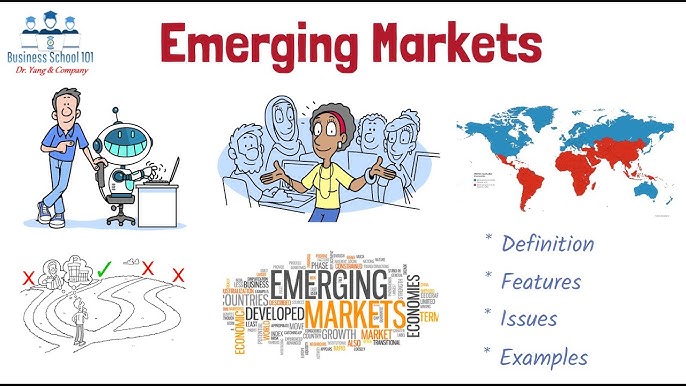
Emerging Football Markets Explained: The New Frontiers of the Beautiful Game
Football, or soccer as it is known in some parts of the world, has long transcended its European and South American heartlands to become a truly global phenomenon. With billions of fans, monumental revenues, and an unparalleled cultural impact, it is the world’s most popular sport. However, as traditional markets in Europe reach saturation points in terms of fan base, sponsorship, and broadcast revenue, the focus of the sport’s major stakeholders – from FIFA and confederations to top clubs and brands – is increasingly shifting towards what are known as "emerging football markets."
These new frontiers represent not just untapped commercial opportunities but also vital avenues for the continued global growth and evolution of the beautiful game. Understanding these markets, their drivers, challenges, and potential, is crucial for anyone involved in the business of football.
What Defines an "Emerging Football Market"?
An emerging football market is typically characterized by several key factors, often in contrast to established markets like the Premier League in England, La Liga in Spain, or the Bundesliga in Germany:
- Large, Growing Population: These markets often boast significant populations, many with a young demographic profile, providing a vast potential fan base.
- Rising Disposable Income and Middle Class: Economic growth leads to increased purchasing power, allowing consumers to spend on sports entertainment, merchandise, and subscriptions.
- Developing Football Infrastructure: While passion for the game may be high, the local leagues, stadiums, training facilities, and youth academies are often still in nascent or developing stages.
- Limited Exposure to Top-Tier Football (Historically): While this is rapidly changing, historical access to live matches, high-quality broadcasts, and direct engagement with top clubs might have been limited.
- Government or Private Sector Investment Potential: Often, there is a strong willingness from governments or wealthy individuals/entities to invest heavily in sports as part of national development, soft power initiatives, or diversification strategies.
- Existing Sports Culture (Potentially Dominant in Other Sports): In some emerging markets, football may compete with other deeply ingrained sports (e.g., cricket in India, basketball in the Philippines, American football/baseball in the USA).
These markets are not static; they are dynamic and evolving, moving along a spectrum from nascent to established.
The Catalysts for Growth: Why Now?
The surge in interest and investment in emerging football markets is driven by a confluence of powerful global trends:
- Economic Globalization and Urbanization: Rapid economic growth in regions like Asia, the Middle East, and parts of Africa has created vast urban centers with growing middle classes and increased disposable income. This demographic shift provides fertile ground for new consumer markets.
- Technological Revolution: The internet, social media, and streaming services have demolished geographical barriers. Fans in remote corners of the world can now instantly access live matches, highlights, news, and engage directly with their favorite clubs and players. This unparalleled accessibility fuels passion and creates a sense of belonging.
- Strategic Investment and Soft Power: Many governments, particularly in the Middle East and Asia, view sports, and football in particular, as a critical tool for national development, tourism promotion, and enhancing their global "soft power." This has led to massive investments in hosting major tournaments (e.g., Qatar 2022 World Cup, Saudi Arabia’s bids), acquiring top clubs (e.g., Newcastle United, Manchester City), and attracting star players (e.g., Saudi Pro League).
- FIFA’s Global Vision: FIFA’s mandate is to grow football worldwide. Initiatives like expanding the World Cup to 48 teams (which necessitates more hosts and increases representation from non-traditional footballing nations) and investing in grassroots development programs underscore this commitment.
- Clubs’ Revenue Diversification: Top European clubs, facing intense competition and saturation in their home markets, are actively seeking new revenue streams from sponsorship, merchandise sales, pre-season tours, and digital fan engagement in these burgeoning regions.
- Youth Demographics: Many emerging markets have a significantly younger population compared to aging Western societies. This youth bulge represents a long-term fan base and talent pool for the sport.
Key Regions and Case Studies
While the term "emerging" can apply to various regions, several stand out for their current impact and future potential:
- North America (USA & Canada): Though historically dominated by other sports, football (soccer) is rapidly gaining ground. The Major League Soccer (MLS) is expanding, attendance records are broken regularly, and youth participation is soaring. The co-hosting of the 2026 FIFA World Cup alongside Mexico is expected to be a monumental catalyst, legitimizing football’s status as a major sport in the region and attracting unprecedented investment and fan engagement. The growth of women’s football (NWSL) is also a significant factor.
- Asia:
- China: Despite recent setbacks in its domestic league and regulatory challenges, China’s sheer population size and government ambition mean its potential remains immense. The passion for European football, particularly the Premier League, is undeniable. Future development hinges on stable domestic league growth and grassroots investment.
- India: A cricket-mad nation, India’s football landscape is rapidly evolving. The Indian Super League (ISL) is gaining traction, and the fan base for European clubs is enormous. With a young, tech-savvy population and growing internet penetration, India is a massive market for digital content and merchandise.
- Japan & South Korea: While more established, these markets continue to grow in sophistication and influence. Their strong domestic leagues (J-League, K-League) produce talent and provide a blueprint for sustainable development, while their fans are deeply engaged with top European clubs.
- Middle East & North Africa (MENA): This region is arguably the most dynamic "emerging" market currently.
- Saudi Arabia: The Saudi Pro League, fueled by the Public Investment Fund (PIF), has aggressively recruited global superstars, dramatically raising its profile. This strategy aims to boost the league’s quality, attract fans, and serve national development goals.
- Qatar & UAE: Following the 2022 World Cup, Qatar is leveraging its infrastructure and experience. The UAE, home to City Football Group’s ownership of Manchester City, has long been a hub for pre-season tours and commercial partnerships, with a growing domestic league and fan base.
- Africa: A continent of immense passion and raw talent, Africa represents a long-term frontier. Countries like Nigeria, Egypt, South Africa, and Morocco have huge populations and fervent fan bases. The challenges here are often infrastructural, governance-related, and financial, but the potential for grassroots development and attracting commercial interest is undeniable. The success of national teams and African players in top European leagues fuels local aspirations.
- Southeast Asia: Nations like Indonesia, Vietnam, and Thailand boast massive, young, and highly engaged fan bases, particularly for the Premier League. While domestic leagues face challenges, the sheer number of fans makes them attractive for brand partnerships and digital engagement.
The Strategic Imperative for Established Clubs and Leagues
For established European clubs and leagues, engaging with emerging markets is no longer optional; it’s a strategic imperative:
- Revenue Diversification: Expanding into new markets opens up fresh avenues for sponsorship deals, merchandise sales, media rights, and pre-season tour revenues.
- Fan Base Expansion: Cultivating new fans globally ensures long-term brand loyalty and commercial viability. These fans often consume content digitally, driving engagement metrics.
- Talent Scouting: Emerging markets represent untapped reservoirs of talent, providing future stars and strengthening global scouting networks.
- Brand Building and Global Presence: A truly global footprint enhances a club’s prestige and market value.
Challenges and Pitfalls
Despite the immense opportunities, navigating emerging football markets comes with significant challenges:
- Infrastructure Deficiencies: Lack of modern stadiums, quality training facilities, and organized youth development structures can hinder growth.
- Governance and Corruption: Issues of transparency, fair play, and consistent regulation can plague nascent leagues, deterring investment and eroding fan trust.
- Financial Sustainability: Over-reliance on a few wealthy owners or government subsidies can lead to boom-and-bust cycles. Developing organic revenue streams (ticketing, local sponsorship, stable broadcast deals) is crucial.
- Cultural Barriers and Competition: In some regions, football must compete with deeply ingrained local sports or cultural pastimes for attention and investment.
- Talent Drain: Promising local players often move to more established leagues abroad, which can weaken the domestic product and fan engagement.
- Authenticity of Engagement: Superficial marketing efforts or short-term tours without genuine long-term investment in local communities can backfire.
- Ethical Concerns: Investing in regions with questionable human rights records or labor practices raises ethical dilemmas that clubs and organizations must navigate carefully.
Strategies for Sustainable Development
To truly flourish, engagement with emerging markets must be thoughtful and long-term:
- Local Partnerships: Collaborating with local businesses, football federations, and community groups is essential for understanding the market and building trust.
- Grassroots Investment: Developing youth academies, coaching programs, and accessible playing facilities creates a sustainable pipeline of talent and future fans.
- Tailored Content and Digital Engagement: Localizing content, leveraging social media, and creating bespoke digital experiences for fans in these regions is vital.
- Knowledge Transfer: Sharing best practices in league management, marketing, player development, and sports science from established markets.
- Long-Term Vision: Avoiding short-term financial grabs in favor of sustained investment that builds local capacity and genuine fan loyalty.
- Ethical Due Diligence: Ensuring investments and partnerships align with ethical standards and contribute positively to local communities.
The Future Landscape
The future of football will undoubtedly be more global and multi-polar. Emerging markets are not just passive recipients of established football culture; they are increasingly active participants and shapers of the game. The rise of new footballing powers, driven by economic strength and strategic ambition, will likely lead to:
- More diverse player pools in top leagues.
- Increased competition for major tournament hosting rights.
- The potential emergence of new "super leagues" or significant regional competitions outside of Europe.
- A shift in global fan demographics and consumption patterns, with digital platforms becoming even more central.
Conclusion
Emerging football markets represent the next frontier for the world’s most popular sport. They offer unparalleled opportunities for growth, innovation, and the further globalization of football. However, unlocking this potential requires a nuanced understanding of local dynamics, a commitment to long-term sustainable investment, and a willingness to navigate complex challenges. As the beautiful game continues its relentless expansion, these emerging markets will not only reshape its commercial landscape but also enrich its cultural tapestry, ensuring football remains truly global and ever-evolving for generations to come.



